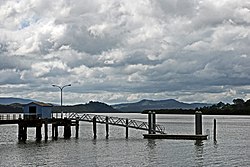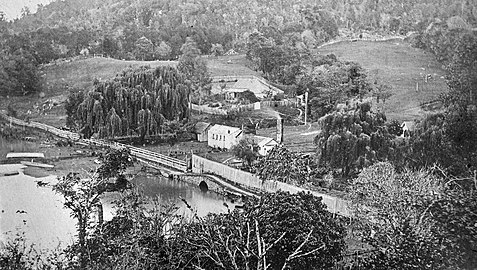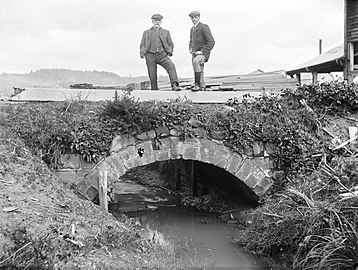Kohukohu, New Zealand
Kohukohu | |
|---|---|
 Kohukohu Wharf | |
 | |
| Coordinates: 35°21′41″S 173°32′39″E / 35.36139°S 173.54417°E | |
| Country | New Zealand |
| Region | Northland Region |
| District | Far North District |
| Ward | Kaikohe/Hokianga |
| Community | Kaikohe-Hokianga |
| Subdivision | North Hokianga |
| Electorates | |
| Government | |
| • Territorial Authority | Far North District Council |
| • Regional council | Northland Regional Council |
| • Mayor of Far North | Moko Tepania |
| • Northland MP | Grant McCallum |
| • Te Tai Tokerau MP | Mariameno Kapa-Kingi |
| Area | |
• Total | 4.26 km2 (1.64 sq mi) |
| Population (June 2024)[2] | |
• Total | 180 |
| • Density | 42/km2 (110/sq mi) |
Kohukohu is a village on the Hokianga Harbour in the Northland Region of New Zealand. It was one of the first European settlements in New Zealand.
Kohukohu is situated on the northern shore of the harbour where it splits into two rivers, the Mangamuka River branching inland to the northeast and the Waihou River leading towards the east past Mangungu, Horeke and Rangiahua.
Where the harbour divides there is a small island called Motiti which was painted by Augustus Earle, the first European artist to spend several months in New Zealand, during his visit to the Hokianga in 1827. He wrote "we were sailing up a spacious sheet of water, which became considerably wider after entering it; while majestic hills rose on each side .... looking up the river we beheld various headlands stretching into the water and gradually contracting its width, 'till they became fainter and fainter in the distance and all was lost in the azure of the horizon".
History and culture
[edit]Pre-European settlement
[edit]According to Te Tai Tokerau tradition, the legendary Polynesian explorer Kupe visited the area prior to his return voyage to Hawaiiki. Angry at the food from the Hāngī (earth oven) being insufficiently cooked, he swore at those responsible.[3] Kohukohu is Māori for a swearword or expletive.[4]

European settlement
[edit]The first recorded European to enter the Hokianga Harbour arrived in 1819 and by the 1830s, Kohukohu was the heart of New Zealand's timber industry.[5] The country's first Catholic mass was celebrated 8 kilometres north of Kohukohu at Totara Point in 1838.[6] The Hokianga Sawmill Company built a sawmill in 1878.
For nearly one hundred years Kohukohu was an important timber milling town and the largest commercial centre on the north of the harbour. In 1900, the township had a population of almost 2,000 people.[7]
Marae
[edit]Kohukohu has three marae affiliated with the hapū Te Ihutai: Pateoro or Te Karae Marae and Pōwhiri meeting house which affiliates with Te Rarawa;[8][non-tertiary source needed] Pikipāria Marae and Ngarunui meeting house which affiliates with Ngāpuhi;[9][non-tertiary source needed] and Tauteihiihi Marae and Tokimatahourua meeting house.[10][non-tertiary source needed]
There are also three marae affiliated with other Te Rarawa hapū: Motuti Marae and Tamatea meeting house are affiliated with Ngāti Tamatea, Ngāti Te Maara and Te Kai Tutae. Ngāi Tupoto Marae and Ngāhuia meeting house are affiliated with Ngāi Tūpoto and Ngāti Here. Waiparera Marae and Nukutawhiti meeting house are affiliated with Patutoka, Tahāwai, Te Whānau Pani and Te Hokokeha.[11][12][non-tertiary source needed]
In October 2020, the Government committed $1,407,731 from the Provincial Growth Fund to upgrade Ngāi Tupoto Marae and 8 other marae of Te Rarawa, creating 100 jobs.[13][non-primary source needed]
Kohukohu Bridge
[edit]The Kohukohu footbridge near the centre of the town is believed to be the first stone bridge built in New Zealand, and is the oldest surviving bridge in New Zealand. It was built some time between 1843 and 1851 at the mouth of the Waihouuru Creek where it flowed into the Hokianga Harbour. At the time, ships from Sydney used sandstone blocks as ballast, which they left at Kohukohu in exchange for more-valuable timber, and these sandstone blocks were used to build the bridge. When a timber mill opened next to the bridge in 1879 sawdust was used to gradually reclaim the harbour, and the reclamation has buried most of the bridge, which is now about 100 m back from the foreshore. The bridge was registered in 2008 as a Category 1 Historic Place.[14][15]
- Kohukohu footbridge
-
Kohukohu c. 1867-1869. The old stone bridge is clearly visible, before the harbour was filled in
-
Kohukohu bridge around 1900 to 1920, with the timber mill visible in the background
-
Kohukohu footbridge today
Demographics
[edit]Statistics New Zealand describes Kohukohu as a rural settlement. It covers 4.26 km2 (1.64 sq mi)[1] and had an estimated population of 180 as of June 2024,[2] with a population density of 42 people per km2. Kohukohu is part of the larger Kohukohu-Broadwood statistical area.[16]
| Year | Pop. | ±% p.a. |
|---|---|---|
| 2006 | 186 | — |
| 2013 | 168 | −1.44% |
| 2018 | 168 | +0.00% |
| 2023 | 180 | +1.39% |
| Source: [17][18] | ||
Kohukohu had a population of 180 in the 2023 New Zealand census, an increase of 12 people (7.1%) since the 2018 census, and an increase of 12 people (7.1%) since the 2013 census. There were 84 males and 96 females in 102 dwellings.[19] 5.0% of people identified as LGBTIQ+. The median age was 59.7 years (compared with 38.1 years nationally). There were 24 people (13.3%) aged under 15 years, 12 (6.7%) aged 15 to 29, 72 (40.0%) aged 30 to 64, and 69 (38.3%) aged 65 or older.[18]
People could identify as more than one ethnicity. The results were 78.3% European (Pākehā), 43.3% Māori, 3.3% Pasifika, and 3.3% Asian. English was spoken by 98.3%, Māori language by 6.7%, Samoan by 1.7% and other languages by 6.7%. No language could be spoken by 1.7% (e.g. too young to talk). New Zealand Sign Language was known by 1.7%. The percentage of people born overseas was 20.0, compared with 28.8% nationally.
Religious affiliations were 31.7% Christian, 3.3% Māori religious beliefs, and 1.7% Jewish. People who answered that they had no religion were 55.0%, and 6.7% of people did not answer the census question.
Of those at least 15 years old, 30 (19.2%) people had a bachelor's or higher degree, 81 (51.9%) had a post-high school certificate or diploma, and 36 (23.1%) people exclusively held high school qualifications. The median income was $23,700, compared with $41,500 nationally. 9 people (5.8%) earned over $100,000 compared to 12.1% nationally. The employment status of those at least 15 was that 36 (23.1%) people were employed full-time, 21 (13.5%) were part-time, and 15 (9.6%) were unemployed.[18]
Education
[edit]Kohukohu School is a co-educational full primary (years 1-8) school[20] with a roll of 29 students as of August 2024.[21] The school was established in 1883, but moved to a new location in 1972 because the ground on the original site was unstable. The original site with the original school building is now a historic reserve.[22]
Notable people
[edit]- James Fisher-Harris, rugby league player for the Penrith Panthers
Notes
[edit]- ^ a b "ArcGIS Web Application". statsnz.maps.arcgis.com. Retrieved 2 April 2022.
- ^ a b "Aotearoa Data Explorer". Statistics New Zealand. Retrieved 26 October 2024.
- ^ Te Ahukaramū Charles Royal (8 February 2005). "Places associated with Kupe". Te Ara Encyclopedia of New Zealand.
- ^ "kohukohu - Māori Dictionary". maoridictionary.co.nz. Retrieved 9 August 2020.
- ^ Shadbolt, Maurice (2010). Reader's Digest Guide to New Zealand. Reader's Digest.
A bawdy timber town from the 1830s
- ^ Shadbolt, Maurice (2010). Reader's Digest Guide to New Zealand. Reader's Digest.
New Zealand's first Catholic mass was celebrated near by in 1838; a memorial 8 kilometres north on Totara Point marks the site.
- ^ Shadbolt, Maurice (2010). Reader's Digest Guide to New Zealand. Reader's Digest.
with a population of 20000 at the turn of the century, it now musters less than 200
- ^ "Pateoro (Te Karae) | Maori Maps". maorimaps.com. Retrieved 9 August 2020.
- ^ "Pikipāria | Maori Maps". maorimaps.com. Retrieved 9 August 2020.
- ^ "Tauteihiihi | Maori Maps". maorimaps.com. Retrieved 9 August 2020.
- ^ "Te Kāhui Māngai directory". tkm.govt.nz. Te Puni Kōkiri.
- ^ "Māori Maps". maorimaps.com. Te Potiki National Trust.
- ^ "Marae Announcements" (Excel). growregions.govt.nz. Provincial Growth Fund. 9 October 2020.
- ^ Park, Stuart (9 September 2007). "Stone Bridge". Heritage New Zealand.
- ^ Douglas, Jamie. Skyes, Caitlyn (ed.). "Crossing Over". Heritage New Zealand. Vol. Winter 2018, no. 149. Heritage New Zealand. pp. 8–9. ISSN 1175-9615.
- ^ 2018 Census place summary: Kohukohu-Broadwood
- ^ "Statistical area 1 dataset for 2018 Census". Statistics New Zealand. March 2020. 7000195.
- ^ a b c "Totals by topic for individuals, (RC, TALB, UR, SA3, SA2, Ward, Health), 2013, 2018, and 2023 Censuses". Stats NZ – Tatauranga Aotearoa – Aotearoa Data Explorer. Kohukohu (1017). Retrieved 3 October 2024.
- ^ "Totals by topic for dwellings, (RC, TALB, UR, SA3, SA2, Ward, Health), 2013, 2018, and 2023 Censuses". Stats NZ – Tatauranga Aotearoa – Aotearoa Data Explorer. Retrieved 3 October 2024.
- ^ Education Counts: Kohukohu School
- ^ "New Zealand Schools Directory". New Zealand Ministry of Education. Retrieved 17 September 2024.
- ^ Macrae, Alan (2011). "Heritage Assessment: Former Kohukohu School" (PDF). Department of Conservation.
External links
[edit]- Kohukohu Community website
- Kohukohu School website
- Village Arts website
- Kohukohu on the Hokianga Tourism Association website



